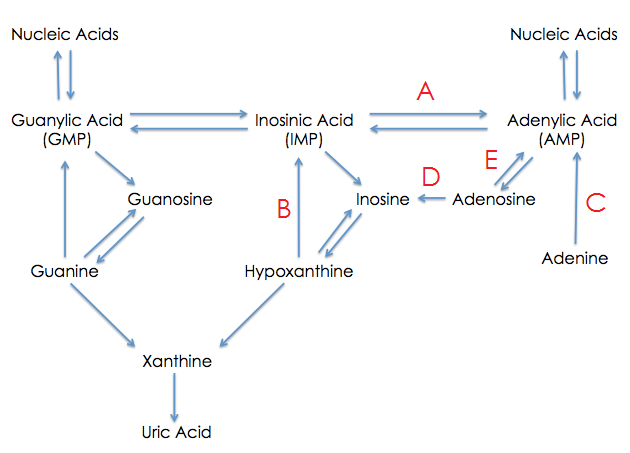WBR0320
Jump to navigation
Jump to search
| Author | [[PageAuthor::Serge Korjian M.D. (Reviewed by Alison Leibowitz) (Reviewed by Serge Korjian)]] |
|---|---|
| Exam Type | ExamType::USMLE Step 1 |
| Main Category | MainCategory::Biochemistry |
| Sub Category | SubCategory::Neurology |
| Prompt | [[Prompt::A 1-year-old boy is brought to the physician's office for failure to thrive. Upon further questioning, the mother explains that the child is aggressive, has abnormal movements and gesturing, and frequently chews his fingertips and lips. Physical examination is remarkable for swelling of the first metatarsophalangeal joint, spasticity, and hyperreflexia. Which of the following enzymes in the diagram is most likely deficient in this patient? |
| Answer A | AnswerA::A |
| Answer A Explanation | AnswerAExp::"A" does not correspond to HGPRT. It corresponds to AMP deaminase. |
| Answer B | AnswerB::B |
| Answer B Explanation | AnswerBExp::"B" corresponds to HGPRT. HGPRT deficiency results in Lesch-Nyhan syndrome. |
| Answer C | AnswerC::C |
| Answer C Explanation | AnswerCExp::"C" corresponds to adenosine phosphoribosyltransferase (APRT). APRT deficiency is an extremely rare disease associated with increased risk of kidney stones. |
| Answer D | AnswerD::D |
| Answer D Explanation | AnswerDExp::"D" corresponds to adenosine deaminase (ADA). Deficiency of ADA is associated with severe combined immunodeficiency (SCID). |
| Answer E | AnswerE::E |
| Answer E Explanation | AnswerEExp::"E" corresponds to adenosine kinase not HGPRT. Severe developmental abnormalities and early postnatal death have been documented in knockout animal models. You are not required to know this information for the USMLE Step 1. |
| Right Answer | RightAnswer::B |
| Explanation | [[Explanation::The patient demonstrates signs and symptoms consistent with Lesch-Nyhan syndrome, an X-linked recessive disorder characterized by the deficiency of hypoxanthine-ribosyl-phosphoribosyltransferase (HGPRT) that normally converts hypoxanthine to inosine monophosphate (IMP), guanine to guanosine monophasphate (GMP), and xanthine to xanthosine monophosphate. As a result, the purine salvage pathway is defective and the patient has to undergo de novo purine synthesis. Lesch-Nyhan syndrome manifests with excessive uric acid production and an increase in purine synthesis, leading to hyperuricemia. Patients often present with mental retardation, failure to thrive, choreoathetosis, and self-mutilation. Joint swelling may also be observed in these patients due to the high prevalence of gouty attacks. Patients with Lesch-Nyhan disease have very few dopaminergic nerve terminals and cell bodies in all dopaminergic pathways including the basal ganglia which is thought to contribute to the neuropsychiatric manifestations of the disease. Educational Objective: Deficiency of hypoxanthine-ribosyl-phosphoribosyltransferase (HGPRT) leads to Lesch-Nyhan syndrome, which is characterized by mental retardation, self-mutilation, hyperuricemia, and choreoathetosis. |
| Approved | Approved::Yes |
| Keyword | WBRKeyword::HGPRT, WBRKeyword::Lesch-Nyhan syndrome, WBRKeyword::Self-mutilation, WBRKeyword::Aggressive behavior, WBRKeyword::Hyperuricemia, WBRKeyword::Gout, WBRKeyword::Hypoxanthine-guanine phosphoribosyltransferase, WBRKeyword::Purine salvage, WBRKeyword::X-linked recessive disorder |
| Linked Question | Linked:: |
| Order in Linked Questions | LinkedOrder:: |
